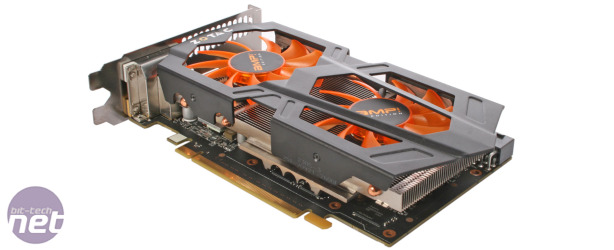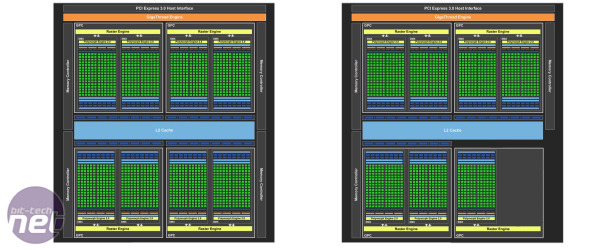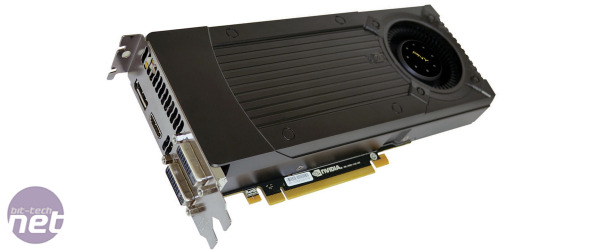
Nvidia GeForce GTX 660 Ti 2GB Review
Manufacturer: NvidiaUK Price (as reviewed): approx £250 (inc VAT)
US Price (as reviewed): approx $299 (ex TAX)
Whilst we've been impressed with Nvidia graphics cards this year thanks to its Kepler GPU's power efficiency and turbo-boosting performance, it's not exactly been in a hurry to fill out its product line. It took AMD just three months to release its 7-series product stack from top-to-bottom, but we've been waiting five months since the launch of the GTX 680 2GB for this, what is arguably the most important card in Nvidia's product line-up, the GTX 660 Ti 2GB.
Custom board-partner versions of cards will be available on launch day
However, those hoping for a sub-£200 card in the vein of both the GTX 460 1GB and GTX 560 Ti 1GB of years past will be disappointed, as the GTX 660 Ti 2GB is set to arrive at e-tailers today for around £250. This will no-doubt leave some deflated (and leave yet more awaiting the inevitable and cheaper GTX 650 Ti), as we know many were hoping for a card substantially cheaper than Nvidia's current high-end offerings.
While the price-tag isn't the most wallet friendly , there's a simple reason for the high price; the GTX 660 Ti 2GB is far from a gutted version of its pricier siblings, and shares a great deal of their Kepler pedigree.
So, what's different?
As with the GTX 690 4GB, GTX 680 2GB and GTX 670 2GB, the GTX 660 Ti 2GB is based around the GK104 version of the Kepler architecture, with the larger and more powerful GK110 GPUs (the direct follow-on to the GTX 580’s full-fat Fermi design) all siphoned off into Nvidia’s Tesla K20 cards.There's a great variety available already when it comes to PCB size and coolers, as this super-short 180mm-long Zotac amp! edition shows.
This means there’s not a great deal for Nvidia to cut from the chip, and as such, GTX 660 Ti 2GB is a very similar GPU to its siblings. Like the GTX 670 2GB, it’s had one of its SMs (streaming multi-processors disabled), dropping the stream processor count from the 1,536 of the GTX 680 2GB to 1,344. The architecture still uses a four GPC (graphics processor cluster) layout though, so there are still four rasterisers per GPU.
The GTX 660 Ti 2GB even shares the same clock speeds as the GTX 670 2GB, shipping with a turbo-boosting base clock of 915MHz and a guaranteed boost clock of 980MHz, although as we’ve seen, cards more often than not, boost considerably higher than this depending on cooling.
Click to enlarge - The Full Kepler architecture of the GTX 680 2GB (left) and cut-down version used in the GTX 660 Ti 2GB (right). Note the disabled memory controller, SM and ROPs.
Nvidia has had to make cuts somewhere to justify the GTX 660 Ti 2GB’s reduced price though, and it’s come by disabling one of the card’s four 64-bit memory controllers. This reduces the memory interface to 192-bit and even with 1.5GHz frequency memory (6GHz effective), the resultant memory bandwidth is a limited 144GB/sec. Switching off a memory controller has also made the ROPs (render out-puts) servicing it redundant, dropping the active ROP count from 32 to 24.
Despite disabling a memory controller though, the GTX 660 Ti 2GB retains the 2GB of memory of its stable-mates. This is done by allowing the GPU to support mixed density GDDR5 modules, or in practise, to connect 1GB of GDDR5 to one of the three remaining memory controllers by double-stacking GDDR5 modules on both sides of the PCB. It’s a similar system to that used by Nvidia with its GTX 550 Ti 1GB cards and a clue as to where this card might have featured in Nvidia’s product stack had the GTX 680 2GB packed a GK110 GPU instead of a GK104.
Cards such as PNY's GTX 660 Ti 2GB XLR8, use the same PCB and cooler as the GTX 670 2GB, but still offer factory overclocks. It's going to be hard to find a non-overclocked version.
As the GTX 660 Ti 2GB is very similar to the GTX 670 2GB many board partners have been able to simply use their GTX 670 2GB PCBs with 660 Ti chips instead. The card still requires a pair of 6-pin PCI-E connectors, but its total TDP is a reduced 150W, down from the 170W of the GTX 670 2GB and 195W of the GTX 680 2GB. Partners have been given free-reign from day one to launch custom PCB and factory overclocked versions of the GTX 660 Ti 2GB and we’ll look at a couple of examples over the next few pages. There will be some card’s based on the same stock design as the GTX 670 2GB though, with PNY one such supplier.
Nvidia GeForce GTX 660 Ti 2GB Specifications
| Nvidia GeForce GTX 660 Ti 2GB | Nvidia GeForce GTX 670 2GB | Nvidia GeForce GTX 680 2GB | Nvidia GeForce GTX 690 4GB | |
| GPU | ||||
| Codename | GK104 | GK104 | GK104 | 2 x GK104 |
| Base Clock | 915MHz | 915MHz | 1,006MHz | 915MHz |
| Boost Clock | 980MHz | 980MHz | 1,058MHz | 980MHz |
| Stream Processors | 1344 | 1344 | 1536 | 1536 |
| Layout | 7 SMs, 4 GPCs | 7 SMs, 4 GPCs | 8 SMs, 4 GPCs | 2 x 8 SMs, 4 GPCs |
| Rasterisers | 4 | 4 | 4 | 2 x 4 |
| Tesselation Units | 7 | 7 | 8 | 2 x 8 |
| Texture Units | 112 | 112 | 128 | 2 x 128 |
| ROPs | 24 | 32 | 32 | 2 x 32 |
| Transistors | 3.54 Billion | 3.54 Billion | 3.54 Billion | 2 x 3.54 Billion |
| Die Size | 294mm² | 294mm² | 294mm² | 2 x 294mm² |
| Process | 28nm | 28nm | 28nm | 28nm |
| Memory | ||||
| Amount | 2GB GDDR5 | 2GB GDDR5 | 2GB GDDR5 | 2 x 2GB GDDR5 |
| Frequency | 1.5GHz (6GHz effective) | 1.5GHz (6GHz effective) | 1.5GHz (6GHz effective) | 1.5GHz (6GHz effective) |
| Interface | 192-bit | 256-bit | 256-bit | 2 x 256 bit |
| Bandwidth | 144 GB/sec | 192 GB/sec | 192 GB/sec | 2 x 192 GB/sec |
| Card Specifications | ||||
| Power Connectors | 2 x 6-pin PCI-E | 2 x 6-pin PCI-E | 2 x 6-pin PCI-E | 2 x 8-pin PCI-E |
| Stock Card Length | 240mm | 240mm | 257mm | 279mm |
| TDP | 150W | 170W | 195W | 300W |
| Typical Street Price | £250 | £300 | £400 | £840 |

MSI MPG Velox 100R Chassis Review
October 14 2021 | 15:04












Want to comment? Please log in.